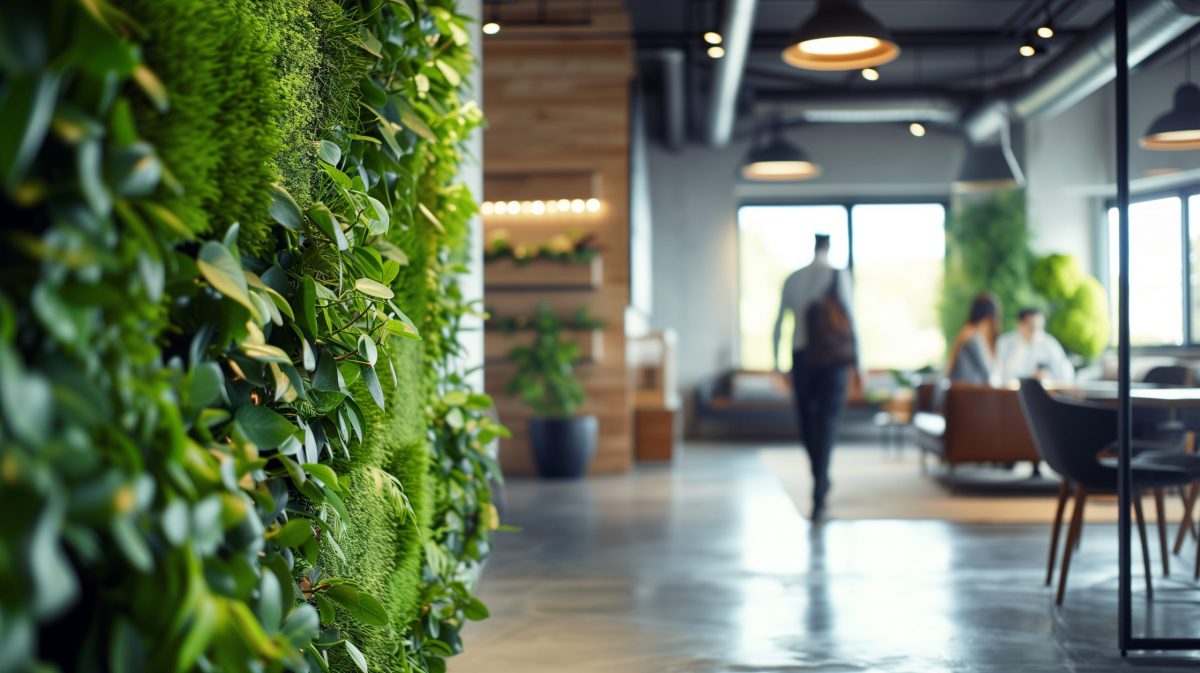Being eco-friendly is more than just a trend, with ongoing global ambitions for net zero and wildlife preservation efforts all being attempts to help maintain the planet for future generations. Given the amount of time an average employee spends in the office every week, businesses are also increasingly seeing how their sustainability efforts can work alongside improving staff well-being and workplace productivity through sustainable office design.
Not to mention the invaluable reputational enhancement that comes with impressed clients walking into a sustainable office unlike any other.
Sustainability and eco-friendly considerations can help make sweeping changes to your existing office design. From office green walls to low-carbon materials, see how our clients have adopted sustainability for a superior office space.
Office Design Tip #1: Eco-Friendly Materials
Perhaps the most obvious and simple way of making a more environmentally-friendly office is to consider the materials you use on every level.
This includes using paints with low volatile organic compounds, recycled glass, reclaimed wood, and carpeting made from recycled plastics. These materials help reduce the carbon footprint of your office while maintaining style and functionality.
Alternatively, simply opting for fewer resources is the most sustainable way to go! Individual work booths for example not only reduce collaboration but use up unnecessary resources.
Where possible, it’s also best to acquire as much of your office furniture and resources from local businesses as you can. That makes it easy to support local businesses and the planet side-by-side!
Office Design Tip #2: Multifunctional Furniture
Multifunctional office furniture is becoming increasingly popular, not just as a way to save space and remove clutter across a desk perhaps, but often thanks to its innovative, eye-catching designs. Choosing furniture that can serve multiple purposes not only saves space but also resources. Consider the following:
- Sit-stand desks: These encourage movement and adaptability.
- Modular sofas: Can be reconfigured for different needs and spaces.
- Nesting tables: Easy to stack and store when not in use, they provide flexibility in meeting rooms or common areas.
Using eco-friendly, locally-produced variations of these will save you space, time, and money by rendering it unnecessary to buy individual furniture for single uses.
Office Design Tip #3: Energy Efficiency
Incorporate energy-efficient appliances and fixtures to reduce your office’s energy consumption.
Especially if your office is part of a larger building, you may simply not have the option to use renewable energy as your primary power source. Despite this, LED lighting, energy star-rated appliances, and smart thermostats can significantly lower your power bills and carbon footprint on a low budget.
You’ll also want to consider the layout of your office. Maximising the potential of natural lighting will reduce the need for artificial lights currently driving up your energy bills.
Office Design Tip #4: Biophilic Design
Biophilia is the emergent concept that aims to improve the connections between humans and the natural environment by incorporating elements of nature into the office design.
This can significantly boost employee well-being and productivity, especially when spending longer hours in the office or during darker, colder winter months. This includes installing living green walls, integrating plant life throughout the office, and maximising views of the outdoors. Natural elements are key to creating a tranquil and stimulating work environment.
The Benefits
Holistically, sustainable office design has proven to deliver an abundance of benefits!
- Reduced Environmental Impact: Eco-friendly practices help conserve resources and reduce waste.
- Cost Efficiency: Energy-efficient solutions can significantly decrease utility bills.
- Enhanced Employee Well-being: Natural light and biophilic elements can increase productivity and reduce stress.
- Positive Corporate Image: Commitment to sustainability can strengthen brand reputation and appeal to like-minded clients and talent.
- Future-proof Investment: Adapting to sustainability prepares your business for future environmental regulations and standards.
Want to learn more about sustainable office design? See more about our latest work in our case studies
Make an enquiry to transform your workspace here

